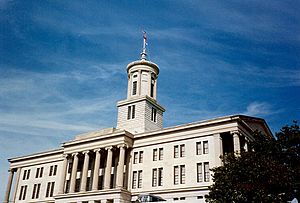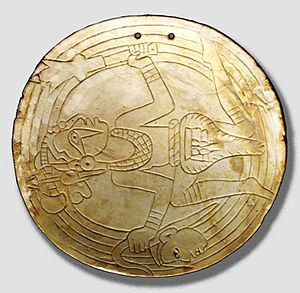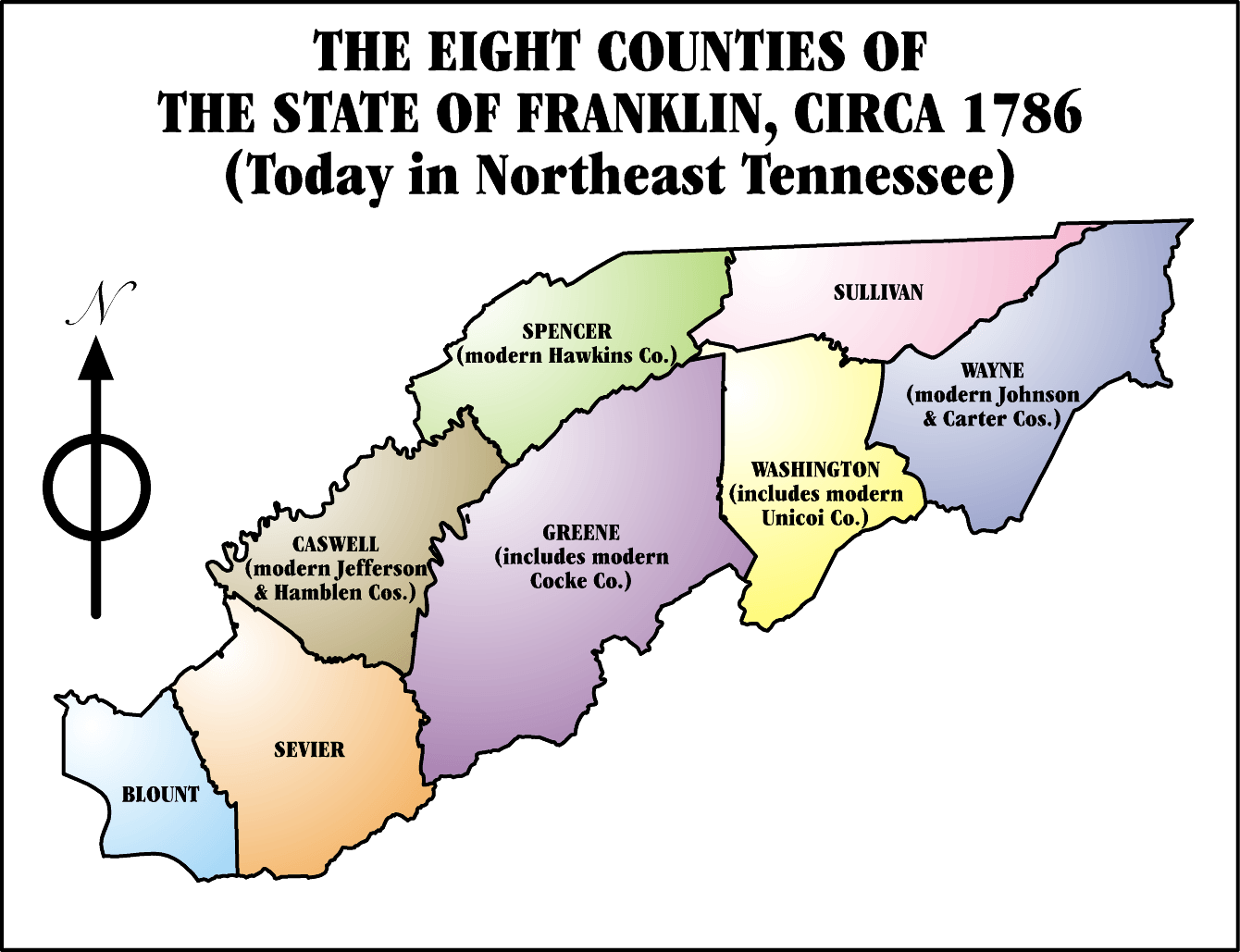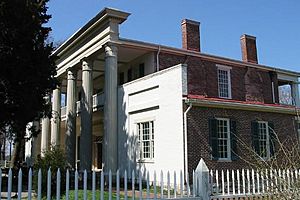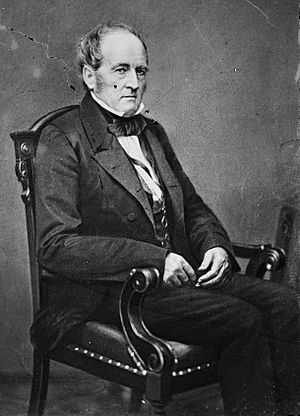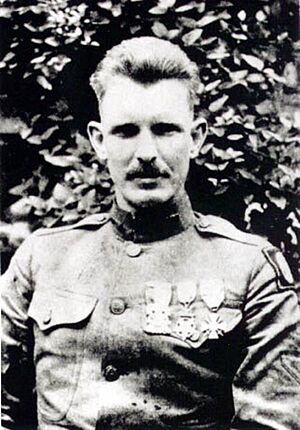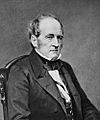History of Tennessee facts for kids
Tennessee is one of the 50 states in the United States. It became the 16th state to join the Union on June 1, 1796. Tennessee is known for its rich history, from ancient Native American cultures to its important role in the Civil Rights Movement. It's also famous as the birthplace of country music!
Contents
- Ancient History: Early People of Tennessee
- European Explorers Arrive in Tennessee
- Early Settlements and Self-Governance
- Tennessee Becomes a State
- Slavery and the Civil War in Tennessee
- Reconstruction and New Challenges
- Celebrating a Century: The Centennial Exposition
- Tennessee in the 20th Century
- Civil Rights Movement and Modern Tennessee
- Tennessee in the 21st Century
- Images for kids
Ancient History: Early People of Tennessee
Long, long ago, about 12,000 years ago, Paleo-Indians were the first people to live and hunt in what is now Tennessee. Archaeologists have even found a 12,000-year-old mastodon skeleton in Williamson County with marks that show it was hunted by these early people.
Later, during the Archaic period (from about 8000 BC to 1000 BC), people lived in places like the Icehouse Bottom site in Monroe County. This site shows that humans lived there as early as 7,500 BC.
The Woodland period (1000 BC to 1000 AD) brought important changes. People started building large earth mounds. Two major sites from this time are the Pinson Mounds in Madison County and the Old Stone Fort in Coffee County. The Pinson Mounds are the biggest Middle Woodland site in the southeastern U.S., with at least 12 mounds.
During the Mississippian period (about 1000 to 1600 AD), villages grew along Tennessee's major rivers. Famous sites include Chucalissa near Memphis and Mound Bottom in Cheatham County. These villages were often fortified with palisades, which were strong fences made of logs.
European Explorers Arrive in Tennessee
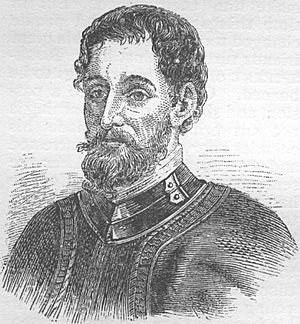
In the 1500s, Spanish explorers were the first Europeans to visit the Tennessee area. Hernando de Soto led an expedition through the Tennessee Valley in 1540. He stayed for a few weeks at a village called Chiaha, near what is now Douglas Dam.
Later, in 1567, the Pardo expedition also visited the Tennessee Valley. One of Pardo's men even built a small fort called San Pedro, but it was destroyed by Native Americans a few years later.
These Spanish explorers wrote down what they saw, giving us the first written records of the people living in the Tennessee Valley. Most people spoke a Muskogean language and lived in farming communities. The Cherokee people lived mainly in the Appalachian Mountains.
French explorers and traders, like Robert de La Salle, came to the region in 1682. They briefly set up a fort called Fort Prudhomme.
Over time, as European colonists moved into the area, Native American groups like the Muscogee, Yuchi, Chickasaw, and Choctaw were forced to move south and west. A very sad event called the Trail of Tears happened from 1838 to 1839. The U.S. government forced nearly 17,000 Cherokee people to march from eastern Tennessee to the Indian Territory (which is now Oklahoma). About 4,000 Cherokee died during this difficult journey. In their language, they called it Nunna daul Isunyi, meaning "The Trail Where We Cried."
Early Settlements and Self-Governance
The Watauga Association
In 1772, early settlers formed the Watauga Association in what is now Elizabethton, Tennessee. They leased land from the Cherokee people at a place called Sycamore Shoals. In 1775, a large land deal known as the Transylvania Purchase happened there. A man named Richard Henderson bought a huge amount of land, including parts of modern Kentucky and Tennessee, from the Cherokee.
However, both the lease and the sale were considered illegal by the British government. A group of Cherokee, led by the war-chief Dragging Canoe, strongly opposed white settlers moving west. They fought against this expansion in what became known as the Cherokee–American wars.
In 1775, the Watauga Association changed its name to the "Washington District" and joined the American colonies that were fighting for independence from Great Britain.
Becoming Part of North Carolina
Before Tennessee became a state, its settlements were part of North Carolina. Six counties were formed: Washington, Sullivan, and Greene in East Tennessee, and Davidson, Sumner, and Tennessee County in Middle Tennessee.
In 1780, a new group of settlers formed the Cumberland Association and created Fort Nashborough on the Cumberland River. These settlements were separated from the eastern ones by a large area of Cherokee land.
After the American Revolutionary War, North Carolina found it difficult and expensive to manage these distant settlements, especially with ongoing conflicts with Native American tribes. The settlers also felt that the national government, under the weak Articles of Confederation, wasn't providing enough support or protection.
The State of Franklin
Feeling ignored by North Carolina, frustrated settlers in East Tennessee decided to form their own state in 1784, called the State of Franklin. John Sevier became its governor. This new state tried to act independently, but it was never officially recognized by the U.S. government.
Leaders in the Cumberland settlements even considered making an alliance with Spain, which controlled the important Mississippi River. These actions showed that early Tennesseans were ready to take charge of their own political future.
North Carolina eventually started to regain control over its western counties. Because of this and disagreements among the East Tennesseans themselves, the State of Franklin ended by 1789.
The Southwest Territory
When North Carolina approved the Constitution of the United States in 1789, it gave its western lands, known as the "Tennessee country," to the U.S. government. Congress then named this area the "Territory of the United States South of the River Ohio," or more simply, the Southwest Territory.
The territory was divided into three areas, each with its own courts and local leaders. President George Washington appointed William Blount, a well-known politician from North Carolina, as the territorial governor.
Tennessee Becomes a State
In 1795, a count showed that the territory had enough people to become a state. Most people voted in favor of joining the Union. Governor Blount called for a special meeting in Knoxville where delegates from all the counties wrote a state constitution and a democratic bill of rights.
The voters chose John Sevier as their first governor. The new state legislature elected William Blount and William Cocke as Senators, and Andrew Jackson as a Congressman.
Tennessee was the first federal territory to ask to join the Union, so there was some debate in Congress about how to handle it. But on June 1, 1796, in a close vote, Congress approved Tennessee's admission as the 16th state of the United States. Its borders were set by extending North Carolina's northern and southern lines to the Mississippi River, which became Tennessee's western boundary.
Slavery and the Civil War in Tennessee
In the early days of Tennessee, wealthy farmers brought enslaved African Americans with them from other states. These enslaved people were forced to work on plantations, especially in Middle and West Tennessee, where crops like cotton became very important. East Tennessee had fewer enslaved people, as it was mostly small farms.
At first, some people in Tennessee supported ending slavery. In 1796, free African Americans were even allowed to vote if they met certain rules. However, efforts to abolish slavery failed, and in 1834, most free African Americans lost their right to vote.
By 1830, the number of enslaved African Americans had grown to over 146,000. This was largely due to the invention of the cotton gin, which made cotton farming very profitable, leading to more plantations and more enslaved people being brought to West Tennessee. By 1860, the enslaved population nearly doubled to 283,019, making up about 25% of the state's total population.
Tennessee and Secession
When the American Civil War began, most Tennesseans did not want to leave the Union. In 1860, they voted for John Bell, a moderate who hoped to avoid a war. In February 1861, 54% of voters were against leaving the Union.
However, after the attack on Fort Sumter in April 1861 and President Abraham Lincoln's call for soldiers to fight the seceded states, public opinion in Tennessee changed quickly. Many people felt that Lincoln's call for troops meant the Union planned to invade the Southern states.
Governor Isham G. Harris began preparing for war and asked the state legislature to vote on leaving the Union. In a vote on June 8, 1861, East Tennessee strongly voted against leaving, while West Tennessee strongly voted in favor. Middle Tennessee's vote decided it, changing from against secession in February to strongly in favor in June. Tennessee became the last state to officially leave the Union and join the Confederacy.
People in East Tennessee were very much against leaving the Union. Many even wanted their counties to separate from Tennessee and form a new state that would stay with the Union. The state legislature in Nashville said no, and Confederate troops were sent to East Tennessee to stop any attempts to secede. Many East Tennesseans fought against the Confederates by burning bridges and cutting telegraph wires.
Major Battles in Tennessee
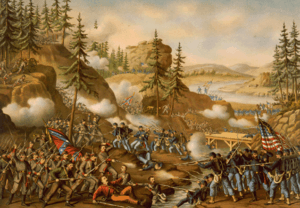
Many important battles of the Civil War were fought in Tennessee, and most of them were Union victories. In February 1862, Ulysses S. Grant and the U.S. Navy took control of the Cumberland and Tennessee Rivers. They also stopped a Confederate attack at the Battle of Shiloh in April. The Union then captured Memphis and Nashville, giving them control of the western and middle parts of the state. This control was confirmed at the Battle of Stones River in January 1863.
After Nashville was captured (it was the first Confederate state capital to fall), Andrew Johnson, who was from East Tennessee, was appointed military governor by President Lincoln. The military government ended slavery in the state, and Union troops occupied much of Tennessee until the war ended.
The Confederates continued to hold East Tennessee for a while, even though many people there supported the Union. In late 1863, the Confederates surrounded Chattanooga but were defeated by Grant in November.
The last major battles in Tennessee happened in November and December 1864. The Confederates invaded but were stopped at Franklin and then completely defeated by George Henry Thomas at Nashville.
Reconstruction and New Challenges
After the Civil War, Tennessee was the first state to be readmitted to the Union, on July 24, 1866. This was because it quickly approved the Thirteenth Amendment, which banned slavery, and the Fourteenth Amendment to the United States Constitution, which gave citizenship and equal rights to former slaves.
Because Tennessee ratified the Fourteenth Amendment, it was the only state that seceded that did not have a military governor during the Reconstruction period. However, many former Confederates were not allowed to vote.
Even though African Americans gained some political power during Reconstruction, white leaders still largely controlled the state. In 1889, Tennessee passed new laws that made it harder for many African Americans and poor white voters to cast their ballots. These laws, like the poll tax, meant that people had to pay a fee to vote. This greatly reduced voting by African Americans, especially in rural areas. Tennessee became a state mostly controlled by white Democrats, except for East Tennessee, which remained Republican due to its Unionist history.
Celebrating a Century: The Centennial Exposition
In 1897, Tennessee celebrated its 100th birthday (a year late!) with a huge event called the Tennessee Centennial Exposition in Nashville. It was a big showcase of new technology and amazing displays.
One of the most famous parts of the exposition was the Nashville Parthenon, a full-size copy of the ancient Greek temple. It was first built from plaster and wood, but later rebuilt with concrete in the 1920s. It's still a popular attraction in Nashville today. The exposition showed how much the South had recovered and grown since the Civil War.
Tennessee in the 20th Century
World War I Hero
Tennessee was home to one of America's most famous soldiers from World War I. Alvin C. York, from Fentress County, Tennessee, was a former conscientious objector (someone who refuses to fight for moral reasons). In October 1918, he bravely captured an entire German machine gun unit by himself in the Argonne Forest. He received the Medal of Honor and became a national hero.
Women's Right to Vote
Tennessee played a key role in the fight for women's voting rights. The movement for women's suffrage (the right to vote) grew in the late 1800s. The Tennessee Equal Suffrage Association was founded in 1906.
In 1920, Governor Albert H. Roberts called a special meeting of the state legislature to decide on approving the Nineteenth Amendment to the United States Constitution, which would give women the right to vote across the country. Leaders from both sides came to Nashville to try and influence the vote. In a very close vote, the amendment passed when a legislator named Harry Burn changed his vote after getting a telegram from his mother telling him to support it!
Tennessee became the crucial state that approved the Nineteenth Amendment, making it law for the entire nation. Women immediately used their new right to vote, helping Warren G. Harding win the presidential election in Tennessee in 1920.
The Scopes Trial
National attention turned to Tennessee again in 1925 during the famous Scopes Trial. The state legislature had passed a law that banned the teaching of evolution in public schools. Some people in Dayton, Tennessee decided to challenge this law by having a high school biology teacher, John T. Scopes, break it. They hoped it would bring publicity to their town.
Their plan worked, and the trial became a huge media event. Thousands of people came to Dayton to watch famous lawyers like William Jennings Bryan (for the prosecution) and Clarence Darrow (for the defense) argue the case.
Tennessee was sometimes made fun of by newspapers in other parts of the country, being called the "Monkey State" or the trial the "Monkey Trial." Scopes was found guilty and fined, but the fine was later canceled. The law itself stayed on the books until 1967.
Birthplace of Country Music
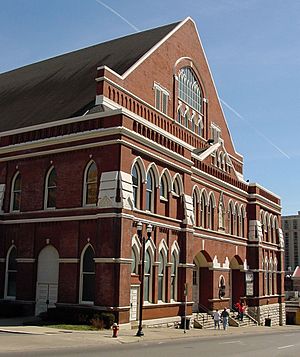
While some people were criticizing Tennessee's rural culture, its music was becoming famous across the nation. In 1925, a powerful Nashville radio station, WSM, started broadcasting a weekly live music show that soon became known as the "Grand Ole Opry." This show featured different kinds of music, like banjo and fiddle bands from Appalachia, gospel singing groups, and country comedy acts. The Opry is still the longest-running radio program in American history.
Two years later, in Bristol, Tennessee, a record company scout recorded Jimmie Rodgers and the Carter Family. These recordings became the first nationally popular rural music records. Tennessee quickly became known as the heartland of traditional country music, with many performers and broadcasts coming from the state.
The Great Depression and TVA
During the Great Depression, many people were unemployed. To create jobs, bring electricity to rural areas, and control floods on the Tennessee River, the U.S. government created the Tennessee Valley Authority (TVA) in 1933. The TVA became the nation's largest public utility and had a huge impact on Tennessee.
The TVA built many hydroelectric dams and coal-fired power plants. This brought cheap and plentiful electricity to Tennessee, especially to farms that had never had it before. By 1945, the TVA was the biggest electricity provider in the country, and its presence helped attract large industries to move to Tennessee, boosting the state's economy.
World War II and Progress
World War II brought relief to Tennessee by providing many jobs. About 10% of the state's population served in the armed forces, and many others worked in war-related industries. Tennessee received war orders worth $1.25 billion.
Tennessee played a secret and very important role in the Manhattan Project, the military's top-secret effort to build an atomic weapon. Research and production for the first atomic bombs took place at a huge scientific and industrial site in Oak Ridge, Tennessee. Oak Ridge grew from empty woods to a city of 70,000 people in just four years!
During this time, laws that made it harder for poor people and African Americans to vote (like the poll tax) were still in place. It wasn't until 1953 that a new state constitutional convention finally removed the poll tax, allowing hundreds of thousands of citizens to vote again.
Civil Rights Movement and Modern Tennessee
Tennessee was a very important place in the struggle for civil rights for African Americans. Many national civil rights leaders, including Dr. Martin Luther King, Jr., learned methods of nonviolent protest at the Highlander Research and Education Center in Monteagle, Tennessee.
In the spring of 1960, college students in Nashville, from Fisk University, American Baptist Theological Seminary, and Vanderbilt University, began challenging the Jim Crow laws that enforced segregation. Led by people like Jim Farmer and John Lewis, they used nonviolent sit-ins to protest segregated lunch counters in downtown Nashville. Even though many were attacked and arrested, they never fought back.
A turning point came when the home of a prominent African-American attorney, Z. Alexander Looby, was bombed. Thousands of protesters marched to Nashville City Hall to confront Mayor Ben West. The mayor spoke with them and agreed that segregation was wrong. This event helped convince downtown lunch counters to desegregate. It was one of the first successful nonviolent protests and a powerful example for the rest of the country.
The hard work and moral arguments of African Americans in the Civil Rights Movement led to the passage of the national Civil Rights Act of 1964 and the Voting Rights Act of 1965. These laws protected the rights of all citizens, including African Americans, to vote and have equal civil rights.
Sadly, in 1968, Dr. Martin Luther King, Jr. was assassinated in Memphis. He was in the city to support a strike by black sanitation workers. His death led to riots and unrest in many cities across the country.
Tennessee in the 21st Century
Tennessee celebrated its 200th birthday in 1996 with a year-long celebration and the opening of a new state park, the Bicentennial Mall, in Nashville.
In 2002, Phil Bredesen became governor, and Tennessee changed its state constitution to allow a state lottery. In 2006, Bob Corker became the first Republican from Tennessee elected to the United States Senate in a long time.
In 2010, Bill Haslam became the 49th Governor of Tennessee. That same year, severe floods hit Middle Tennessee, devastating Nashville and other areas. In 2011, parts of East Tennessee were hit by a historic tornado outbreak.
Images for kids
-
The Tennessee State Capitol in Nashville
-
The 1982 World's Fair in Knoxville


